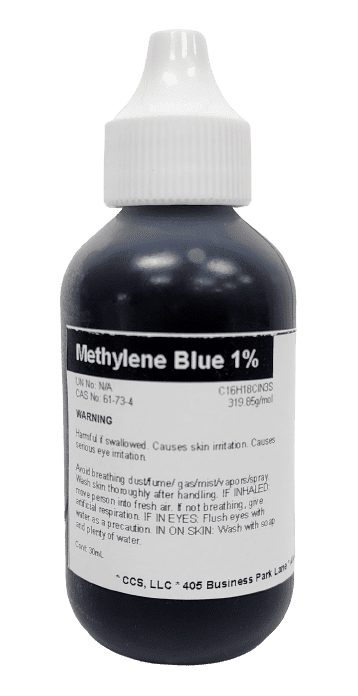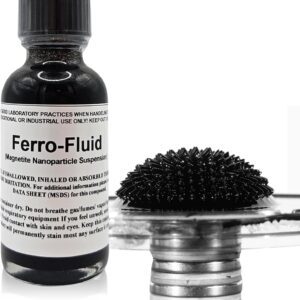Methylene Blue 1% Aqueous Stain/dye Solution
$7.00 – $9.00
Methylene Blue, 1% aqueous Stain/dye Solution
- Packaged in a Dropper Bottle
- Concentrated 1% Solution goes a very long way
- For Staining/Dye Use Only
- One of the most commonly used stains in biology
Description
Methylene Blue, 1% aqueous Stain/dye Solution
- Packaged in a Dropper Bottle
- Concentrated 1% Solution goes a very long way
- For Staining/Dye Use Only
- One of the most commonly used stains in biology
Synonyms: Basic Blue 9,trihydrate; Methelyne blue trihydrate; 3,7-Bis(dimethylamino)phenazathionium chloride trihydrate CAS No.: 7220-79-3 (Trihydrate) Molecular Weight: 373.91 Chemical Formula: C16H18ClN3S
Methylene Blue is a cationic stain. In simple terms, it is a blue dye that is charged positively and binds the negatively charged components of the cells such as the nucleus, DNA or RNA present in the cytoplasm. These cells usually have a low affinity. It is a popular stain used for a variety of activities, including bacterial identification and cellular structure in both plant cells and animal cells. Methylene Blue solution is used to stain the cells. The purpose of staining with methylene blue is to determine cell mortality. When methylene blue stain is given to a sample, a healthy cell causes the stain to become colourless.
Methylene blue is used for several purposes, including as an antidepressant, a treatment for cyanide poisoning, and a titration indicator in a laboratory. It turns dark blue when it is dissolved in water. It is utilized in a number of scientific investigations for a variety of procedures. It is an efficient redox indicator in chemistry because it turns clear when it comes into touch with reducing substances. It is used as a titration aid in solutions. It’s also employed as a pigment in microbiology to analyze nucleic acid chains. It can be added to a solution to colour RNA and DNA for visual analysis.
Methylene Blue can be used as a counterstain. For using counterstain you have to decolourize the primary stain using a decolorizing agent (an acid-alcohol solution)
For determining cell damage: When methylene blue stain is introduced to a sample of cells or tissue, a healthy cell causes the stain to become colourless. This is because the enzymes in the cell degrade the methylene blue, causing it to lose its colouration. Because the enzymes in the cell have been inactivated by the dye, there will be no response if the cell is dead.
Identification of Microorganisms: Methylene blue is a dye frequently employed by biologists to aid in the identification of microorganisms. As the bacteria are nearly colourless, a biologist can detect bacterial forms and structures by adding a drop or two of methylene blue to a microscope slide. In biology, a stain is a dye such as methylene blue. It acts by attracting chemicals to biological tissues and binding to them.
Identifying Nucleic Acids: When methylene blue comes into contact with acids, it turns a vivid shade of blue. This characteristic makes it extremely valuable for identifying nucleic acids such as DNA and RNA. It can also be used in cellular structure, gram’s staining techniques as an alternative to chemical crystal violet.
Identifying RNA Sequences: Because of its affinity for nucleic acids, methylene blue has been employed in specialized procedures such as “northern blotting” to identify RNA sequences (also called “northern hybridization”). Furthermore, methylene blue is a safer alternative to another chemical known as ethidium bromide, which is frequently employed in the viewing of DNA on gels in procedures known as “western blots.
Calculating viable cells in yeast sample: Methylene blue has also been used to calculate the proportion of viable cells in a yeast sample quickly. Dead yeast cells lack an enzyme that decolorizes methylene blue, but living yeast cells do. As a result, when yeast cells are suspended in a dye-containing solution, the dye colours the dead cells blue while leaving the living cells uncoloured.
Identifying distinctions between bacterial, viral and fungal diseases: A technique used to identify and distinguish between bacterial, viral, and fungal diseases is the basic staining approach used by Löffler in alkaline methylene blue staining. Because the positively charged methylene blue dye is attracted to negatively charged particles such as DNAs, RNAs and polyphosphates, it is a cationic dye that stains cells blue. Swabbed specimens from patients are spread onto microscope slides, and the methylene blue solution is placed on the surface. The slide is viewed under a microscope after being covered with a glass coverslip.
Methylene blue can also be used as a surgical and medical marking stain (albeit it can induce localized tissue inflammation), as a diagnostic agent in renal function testing, and as a vital nerve staining agent.
Furthermore, methylene blue is employed to enhance the visibility of the interaction between Fehling’s solution and reducing sugars. It is also used as a reagent in volumetric redox titrations.
methylene blue stain is used in the experiment to increase the visibility of biological components. It selectively stains certain tumour cells of the head, neck and mouth in cancer operations.
Additional information
| size | 30mL, 60mL |
|---|





